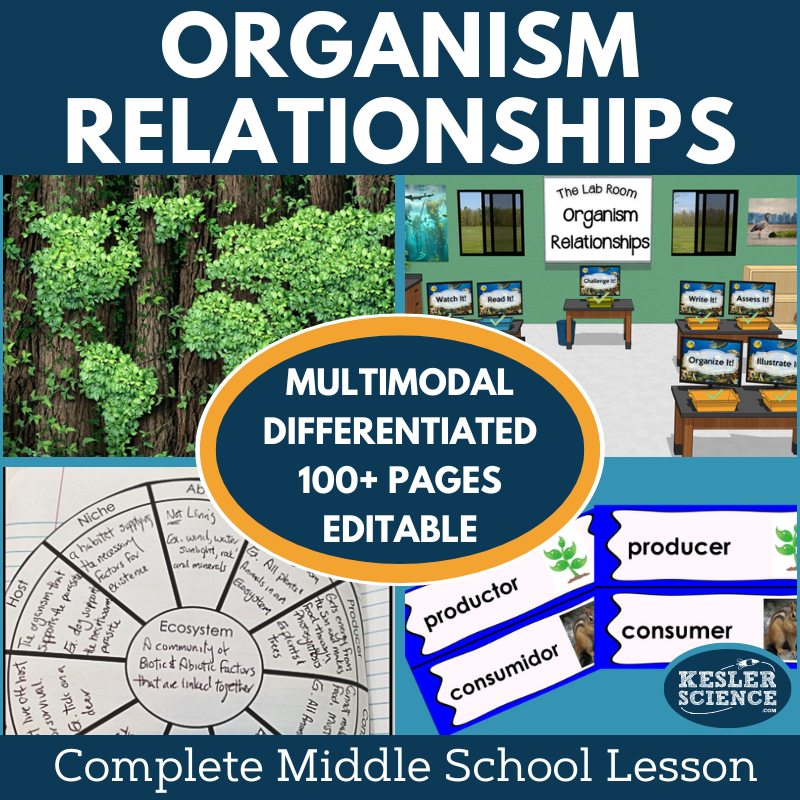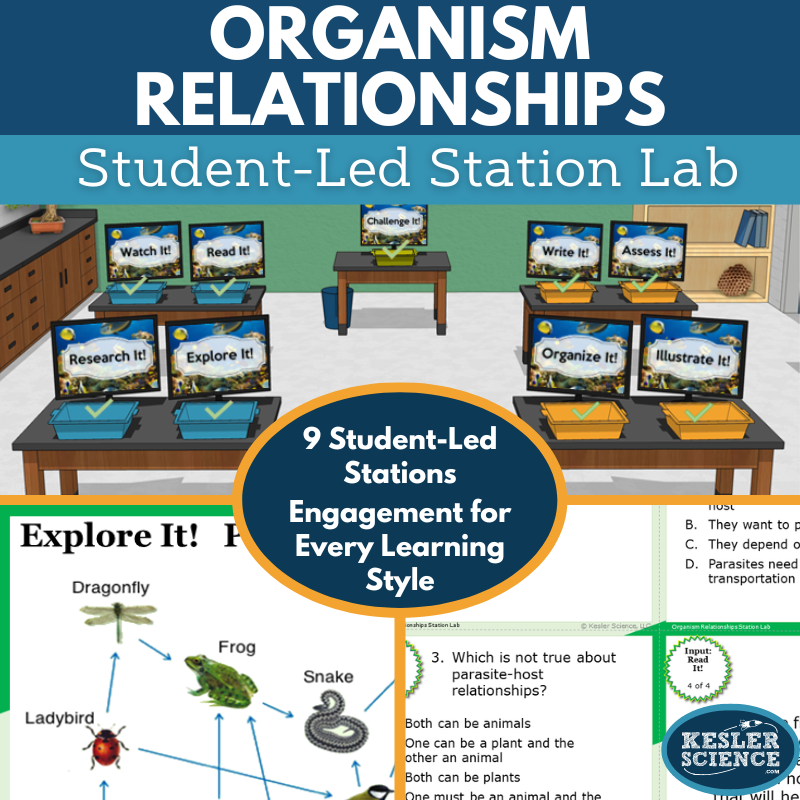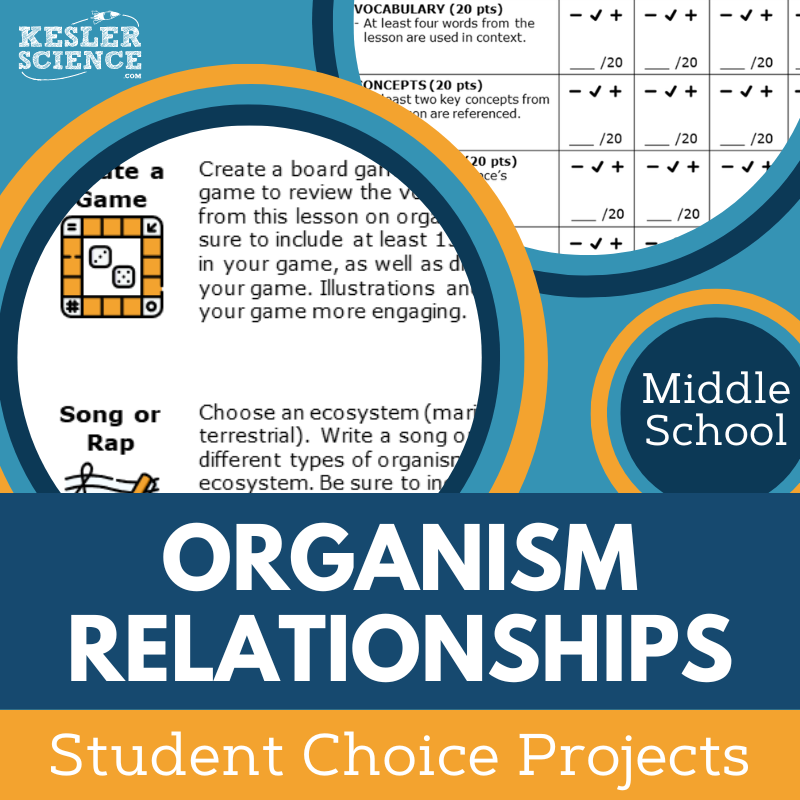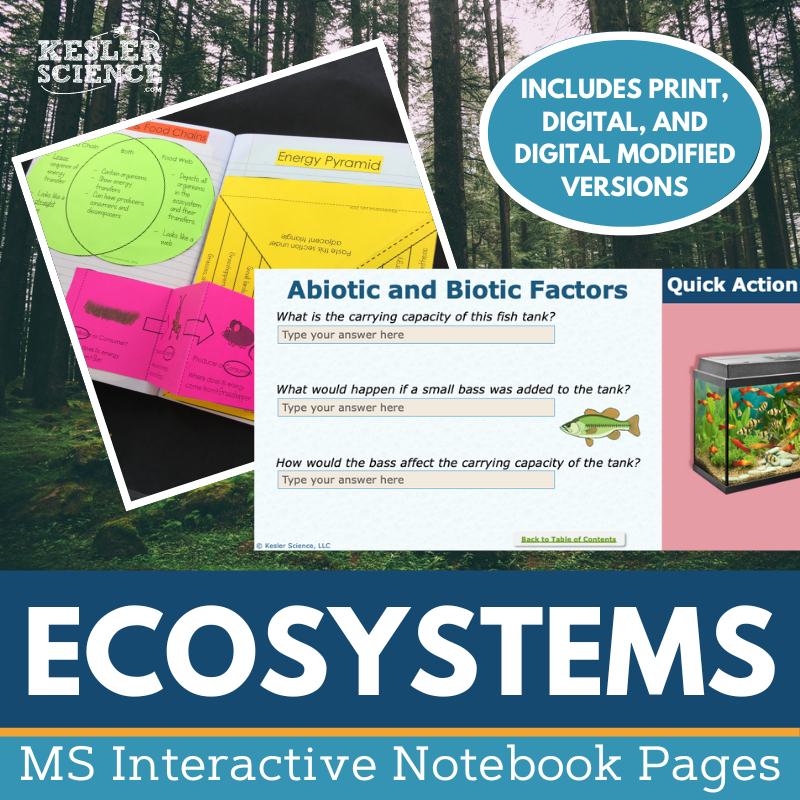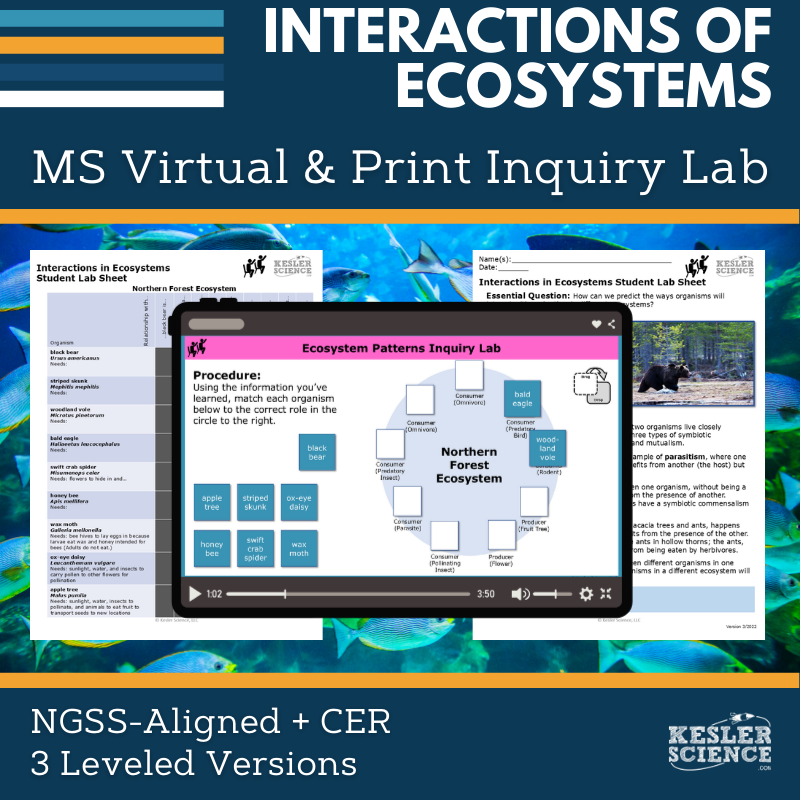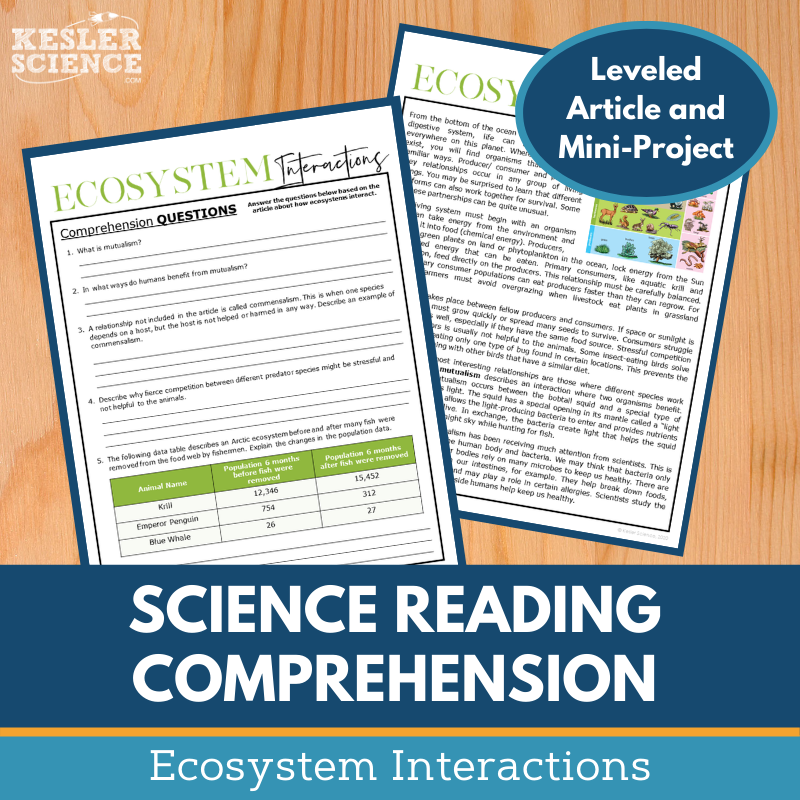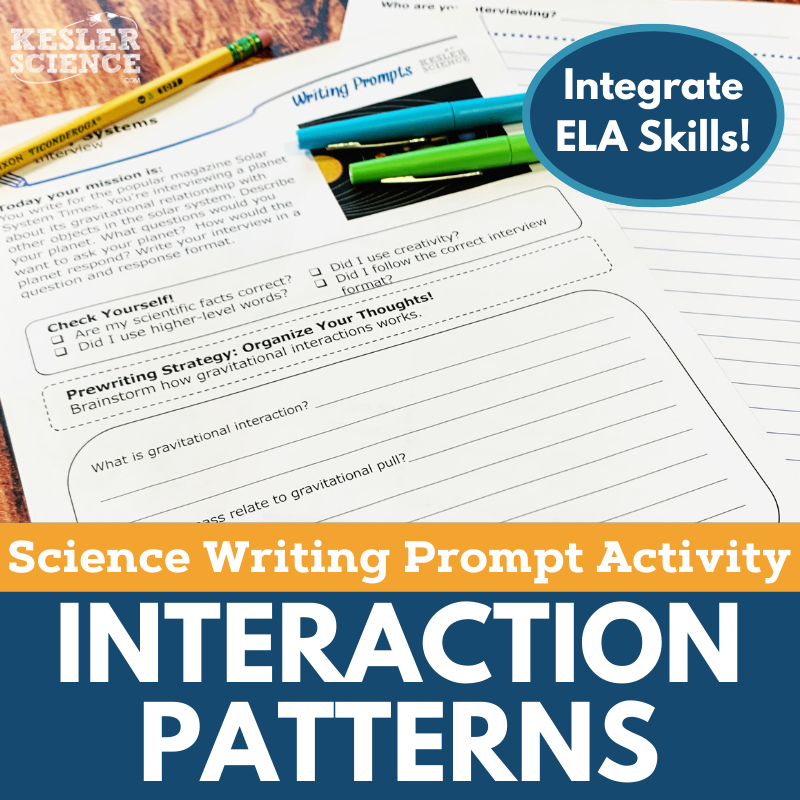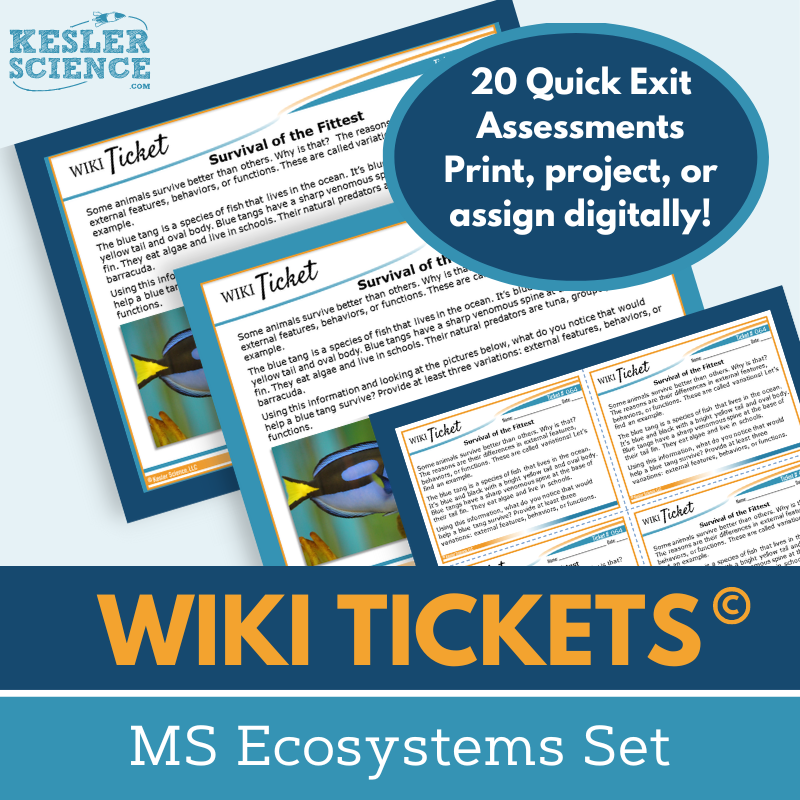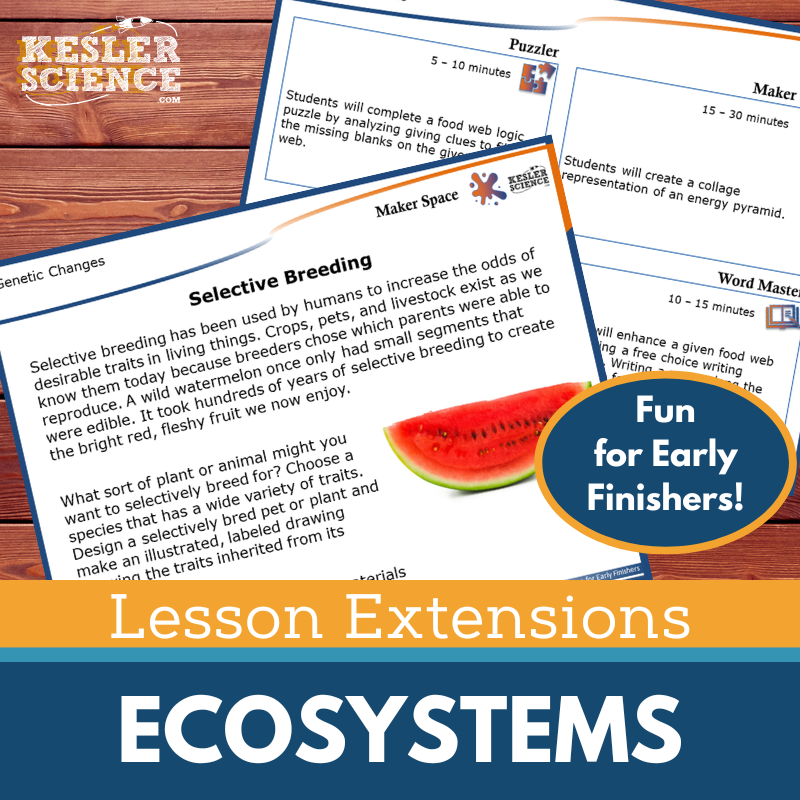Organism Relationships Activities for Middle School Science
The Kesler Science Organism Relationships resources provide everything middle school teachers need to teach predator/prey, consumer/producer, and parasite/host relationships in marine, freshwater, and terrestrial ecosystems. The resources below will give students a comprehensive understanding of organism relationships. All of the following materials are also included in the Kesler Science Membership.
The Kesler Science Complete 5E Lesson on food web relationships provides everything needed for an engaging middle school unit on ecosystem interactions. Students will explore concepts like predator/prey, consumer/producer, and parasite/host relationships across marine, freshwater, and terrestrial ecosystems. This fully editable, multiday resource minimizes prep while maximizing student engagement through differentiated, student-led learning.
Aligned with the 5E Model, the lesson includes interactive activities for each phase: engagement features vocabulary cards and discussion prompts; exploration uses a nine-station lab with multimodal input and output activities; explanation offers editable presentations and interactive notebook templates in English and Spanish. Elaboration includes student-choice projects, while evaluation provides standards-aligned assessments in dependent and modified versions.
This resource is flexible for in-person or virtual learning environments. From hands-on station labs to customizable digital materials, it supports various learning styles and academic needs, ensuring an accessible and comprehensive approach to teaching food web relationships.
The Kesler Science Complete 5E Lesson on food web relationships provides everything needed for an engaging middle school unit on ecosystem interactions. Students will explore concepts like predator/prey, consumer/producer, and parasite/host relationships across marine, freshwater, and terrestrial ecosystems. This fully editable, multiday resource minimizes prep while maximizing student engagement through differentiated, student-led learning.
Aligned with the 5E Model, the lesson includes interactive activities for each phase: engagement features vocabulary cards and discussion prompts; exploration uses a nine-station lab with multimodal input and output activities; explanation offers editable presentations and interactive notebook templates in English and Spanish. Elaboration includes student-choice projects, while evaluation provides standards-aligned assessments in dependent and modified versions.
This resource is flexible for in-person or virtual learning environments. From hands-on station labs to customizable digital materials, it supports various learning styles and academic needs, ensuring an accessible and comprehensive approach to teaching food web relationships.
The Kesler Science modular, student-led Organism Relationships Station Lab offers an engaging and comprehensive way for middle school students to explore interactions between organisms in ecosystems. With differentiated activities and a bonus challenge station, this lab empowers students to direct their learning while teachers facilitate, saving valuable prep time.
The nine stations are divided into input and output activities. Input stations, like "Explore It!" and "Watch It!," provide multimodal opportunities to learn new concepts through hands-on demonstrations, research, and videos. Output stations, such as "Organize It!" and "Illustrate It!," allow students to demonstrate their understanding through creative and interactive tasks, written responses, and visual models.
Adaptable for both in-person and virtual learning, this resource includes all necessary materials, such as task cards, signage, and resources for independent or group work. With flexible formats and differentiated options, this station lab ensures accessibility for a wide range of learning styles and academic needs.
The Kesler Science modular, student-led Organism Relationships Station Lab offers an engaging and comprehensive way for middle school students to explore interactions between organisms in ecosystems. With differentiated activities and a bonus challenge station, this lab empowers students to direct their learning while teachers facilitate, saving valuable prep time.
The nine stations are divided into input and output activities. Input stations, like "Explore It!" and "Watch It!," provide multimodal opportunities to learn new concepts through hands-on demonstrations, research, and videos. Output stations, such as "Organize It!" and "Illustrate It!," allow students to demonstrate their understanding through creative and interactive tasks, written responses, and visual models.
Adaptable for both in-person and virtual learning, this resource includes all necessary materials, such as task cards, signage, and resources for independent or group work. With flexible formats and differentiated options, this station lab ensures accessibility for a wide range of learning styles and academic needs.
The Kesler Science Organism Relationships Student Choice Projects offer middle school students the opportunity to showcase their learning through creative, student-led projects. With six predefined project options and a “design your own” choice, students can select the format that best suits their interests and output style. A customizable grading rubric supports teacher, peer, or self-assessment, making the process flexible and adaptable.
This resource includes a choice board with nine project options, teacher direction pages, and editable rubrics assessing vocabulary, concepts, clarity, and accuracy. Differentiated materials ensure all learners are supported, with modified options for students needing assistance and advanced challenges for those seeking enrichment.
Designed with practicality in mind, the projects use common classroom supplies such as paper, markers, and scissors, with the flexibility to complete many projects digitally. These engaging activities promote creativity while reinforcing understanding of organism relationships.
The Kesler Science Organism Relationships Student Choice Projects offer middle school students the opportunity to showcase their learning through creative, student-led projects. With six predefined project options and a “design your own” choice, students can select the format that best suits their interests and output style. A customizable grading rubric supports teacher, peer, or self-assessment, making the process flexible and adaptable.
This resource includes a choice board with nine project options, teacher direction pages, and editable rubrics assessing vocabulary, concepts, clarity, and accuracy. Differentiated materials ensure all learners are supported, with modified options for students needing assistance and advanced challenges for those seeking enrichment.
Designed with practicality in mind, the projects use common classroom supplies such as paper, markers, and scissors, with the flexibility to complete many projects digitally. These engaging activities promote creativity while reinforcing understanding of organism relationships.
The Kesler Science Ecosystems Interactive Notebook Bundle provides an engaging and interactive way for students to explore key ecosystems concepts. Designed for flexibility, the resource includes both print and digital versions, making it suitable for traditional classrooms, 1:1 environments, and distance learning settings.
The bundle covers a wide range of topics, including biotic and abiotic factors, biomes, food webs, symbiosis, and the nitrogen and carbon cycles. Digital features include a unique interactive notebook PowerPoint, editable Google Slides compatibility, reflection pages, and modified versions for students with accommodations. The paper version includes blank and pre-filled templates, complete with color examples to guide students and teachers.
This resource supports differentiated instruction and accommodates all learners with thoughtfully designed templates and modifications. Whether in person or online, the Ecosystems Interactive Notebook promotes active learning, critical thinking, and scientific literacy.
The Kesler Science Ecosystems Interactive Notebook Bundle provides an engaging and interactive way for students to explore key ecosystems concepts. Designed for flexibility, the resource includes both print and digital versions, making it suitable for traditional classrooms, 1:1 environments, and distance learning settings.
The bundle covers a wide range of topics, including biotic and abiotic factors, biomes, food webs, symbiosis, and the nitrogen and carbon cycles. Digital features include a unique interactive notebook PowerPoint, editable Google Slides compatibility, reflection pages, and modified versions for students with accommodations. The paper version includes blank and pre-filled templates, complete with color examples to guide students and teachers.
This resource supports differentiated instruction and accommodates all learners with thoughtfully designed templates and modifications. Whether in person or online, the Ecosystems Interactive Notebook promotes active learning, critical thinking, and scientific literacy.
The Kesler Science Ecosystem Interactions Inquiry Lab aligns with NGSS MS-LS2-2 and helps students construct explanations that predict patterns of interactions among organisms across different ecosystems. Students will first investigate the relationships within a northern forest ecosystem, then compare those findings to another ecosystem to make predictions about organism roles and interactions.
Both print and digital versions of the lab are included, allowing for flexible instruction whether students are in the classroom or working remotely. Each version contains comprehension questions, C.E.R. prompts, and a reflection section. Teachers can choose from three levels of scaffolding—dependent, modified, and independent—ensuring appropriate support for all learners.
The print lab requires only an internet-connected device per group, while the digital version is fully interactive and needs no additional materials. Editable PowerPoints, teacher guides, and answer keys are included to streamline preparation and grading.
The Kesler Science Ecosystem Interactions Inquiry Lab aligns with NGSS MS-LS2-2 and helps students construct explanations that predict patterns of interactions among organisms across different ecosystems. Students will first investigate the relationships within a northern forest ecosystem, then compare those findings to another ecosystem to make predictions about organism roles and interactions.
Both print and digital versions of the lab are included, allowing for flexible instruction whether students are in the classroom or working remotely. Each version contains comprehension questions, C.E.R. prompts, and a reflection section. Teachers can choose from three levels of scaffolding—dependent, modified, and independent—ensuring appropriate support for all learners.
The print lab requires only an internet-connected device per group, while the digital version is fully interactive and needs no additional materials. Editable PowerPoints, teacher guides, and answer keys are included to streamline preparation and grading.
This Science Reading Comprehension Passage helps middle school students explore patterns of interactions among organisms in different ecosystems. Through a leveled nonfiction article, students learn how species work together to survive, then answer comprehension questions and complete a mini-project in which they profile an ecosystem and its interactions.
The resource includes two versions of the article (Lexile levels 1100–1300), 5–7 comprehension questions, a hands-on mini-project, and a Cornell notes template. Designed for grades 6–8, the materials feature engaging graphics and can be printed in grayscale. The content supports both in-class and remote learning through editable files compatible with Google Classroom, MS Teams, Schoology, and Canvas.
Perfect for sub plans, extra credit, ISS, or full-class instruction, this resource builds science literacy and supports textual analysis. Teachers can integrate the passage throughout a unit to reinforce key concepts, prompt classroom discussions, and strengthen students’ reading comprehension skills.
This Science Reading Comprehension Passage helps middle school students explore patterns of interactions among organisms in different ecosystems. Through a leveled nonfiction article, students learn how species work together to survive, then answer comprehension questions and complete a mini-project in which they profile an ecosystem and its interactions.
The resource includes two versions of the article (Lexile levels 1100–1300), 5–7 comprehension questions, a hands-on mini-project, and a Cornell notes template. Designed for grades 6–8, the materials feature engaging graphics and can be printed in grayscale. The content supports both in-class and remote learning through editable files compatible with Google Classroom, MS Teams, Schoology, and Canvas.
Perfect for sub plans, extra credit, ISS, or full-class instruction, this resource builds science literacy and supports textual analysis. Teachers can integrate the passage throughout a unit to reinforce key concepts, prompt classroom discussions, and strengthen students’ reading comprehension skills.
The Interaction Patterns science writing activity engages middle school students in life science through creative journal-style entries. Designed to align with NGSS MS-LS2-2, the prompt encourages students to explore and explain patterns of interactions among organisms across ecosystems. This low-prep activity supports science reasoning and writing skills and can be used in both print and digital formats, making it ideal for in-person or virtual learning environments.
This resource includes teacher directions, rubrics, full- and half-sheet handouts, and a digital interactive version in PowerPoint or Google Slides. The writing prompt features student checklists, prewriting strategies, and visual templates that can be printed in black and white. The materials are flexible and easy to use, with versions suitable for projection or integration into interactive notebooks.
The journal entry activity is perfect as a cross-curricular writing task, pre-test assessment, student choice project, or enrichment for early finishers. It also works well for make-up work, extra credit, TELPAS samples, and differentiated instruction. Whether displayed on a bulletin board or collected into a student anthology, this writing prompt supports both creativity and science literacy.
The Interaction Patterns science writing activity engages middle school students in life science through creative journal-style entries. Designed to align with NGSS MS-LS2-2, the prompt encourages students to explore and explain patterns of interactions among organisms across ecosystems. This low-prep activity supports science reasoning and writing skills and can be used in both print and digital formats, making it ideal for in-person or virtual learning environments.
This resource includes teacher directions, rubrics, full- and half-sheet handouts, and a digital interactive version in PowerPoint or Google Slides. The writing prompt features student checklists, prewriting strategies, and visual templates that can be printed in black and white. The materials are flexible and easy to use, with versions suitable for projection or integration into interactive notebooks.
The journal entry activity is perfect as a cross-curricular writing task, pre-test assessment, student choice project, or enrichment for early finishers. It also works well for make-up work, extra credit, TELPAS samples, and differentiated instruction. Whether displayed on a bulletin board or collected into a student anthology, this writing prompt supports both creativity and science literacy.
The Kesler Science Ecosystems WIKI Tickets are versatile formative assessments designed for 6th-8th grade science topics. These engaging assessments come in five formats for each topic: full screen for projection, three handout sizes (full, split, and quarter-page), and a digital interactive version that can be used as an editable PPT or Google Slides file. Perfect for checking understanding, these WIKI Tickets provide flexible options for in-person and virtual learning environments.
Aligned with NGSS and TEKS standards, each WIKI Tickets set includes a variety of topics like biodiversity, ecosystems, photosynthesis, and human impact. A bonus table of contents helps teachers quickly find the alignment for each standard. Some topics even have multiple tickets to reinforce key concepts and support student learning.
These assessments are ideal for use as exit tickets, bellringers, or anytime you need quick feedback on student progress. With digital and print formats available, they can be easily adapted for any classroom setting, providing a fun and effective way to gauge students' understanding of science concepts.
The Kesler Science Ecosystems WIKI Tickets are versatile formative assessments designed for 6th-8th grade science topics. These engaging assessments come in five formats for each topic: full screen for projection, three handout sizes (full, split, and quarter-page), and a digital interactive version that can be used as an editable PPT or Google Slides file. Perfect for checking understanding, these WIKI Tickets provide flexible options for in-person and virtual learning environments.
Aligned with NGSS and TEKS standards, each WIKI Tickets set includes a variety of topics like biodiversity, ecosystems, photosynthesis, and human impact. A bonus table of contents helps teachers quickly find the alignment for each standard. Some topics even have multiple tickets to reinforce key concepts and support student learning.
These assessments are ideal for use as exit tickets, bellringers, or anytime you need quick feedback on student progress. With digital and print formats available, they can be easily adapted for any classroom setting, providing a fun and effective way to gauge students' understanding of science concepts.
The Kesler Science Ecosystems Lesson Extensions offer student-choice activities to challenge fast finishers and encourage critical thinking. These activities provide engaging ways to deepen learning and can be used to wrap up lessons, prevent distractions, or fill gaps during testing. Each extension is designed to scaffold learning with activities that align with NGSS and TEKS standards, making them perfect for students ready to explore topics like ecosystems in more depth.
Included in each Lesson Extension are four activity types: Puzzler, Maker Space, Tech Connection, and Word Master. These activities focus on problem-solving, STEAM connections, digital media, and creative writing, providing opportunities for students to apply their knowledge in diverse and engaging ways. Both digital and paper versions are available, with teacher directions and answer keys for easy implementation.
These extensions are ideal for pushing independent learners further, offering rigorous, fun, and hands-on learning opportunities. With topics ranging from biodiversity to ecosystems and environmental changes, these resources help extend students' understanding of science concepts while reinforcing critical skills.
The Kesler Science Ecosystems Lesson Extensions offer student-choice activities to challenge fast finishers and encourage critical thinking. These activities provide engaging ways to deepen learning and can be used to wrap up lessons, prevent distractions, or fill gaps during testing. Each extension is designed to scaffold learning with activities that align with NGSS and TEKS standards, making them perfect for students ready to explore topics like ecosystems in more depth.
Included in each Lesson Extension are four activity types: Puzzler, Maker Space, Tech Connection, and Word Master. These activities focus on problem-solving, STEAM connections, digital media, and creative writing, providing opportunities for students to apply their knowledge in diverse and engaging ways. Both digital and paper versions are available, with teacher directions and answer keys for easy implementation.
These extensions are ideal for pushing independent learners further, offering rigorous, fun, and hands-on learning opportunities. With topics ranging from biodiversity to ecosystems and environmental changes, these resources help extend students' understanding of science concepts while reinforcing critical skills.
Year-Round Resources
These year-round activities will increase your students' understanding of many middle school science topics. All of these activities are also included in the Kesler Science Membership.
Visual Data & Graphing
You're not alone if your students struggle with understanding graphs, charts, and tables. It's a skill that takes an enormous amount of practice. This resource will help students build a strong foundation in analyzing data and creating their own data visualizations.
Bell Ringers and Warm-Ups
These middle school science bell ringers are an excellent way to engage your students as soon as they walk into your classroom. This comprehensive FULL YEAR resource includes everything you need to start off each science class with an interesting warm-up activity.
Review Board Games
Each game board has been carefully designed to keep students engaged. There are 10 different action spaces on each board and dozens of question cards. All of the actions are related to science concepts and keep the students motivated throughout the game.
Each game is ready to play. Simply print out the board and the cards and let the students enjoy reviewing nine different units.
Essential Questions
Below are the essential questions associated with the lessons and activities included in this unit. This topic is only one of more than 100 middle school science topics included in the Kesler Science Membership.
-
Describe organisms’ relationships in a food web, including: predator/prey, consumer/producer, and parasite/host.
-
Describe organism relationships in marine, freshwater, and terrestrial ecosystems.
Kesler Science Membership
Imagine never having to search for another middle school science lesson again. The membership gives you access to ALL of the Kesler Science products in one place (Yes, including everything above).
Say goodbye to long hours of lesson prep.

